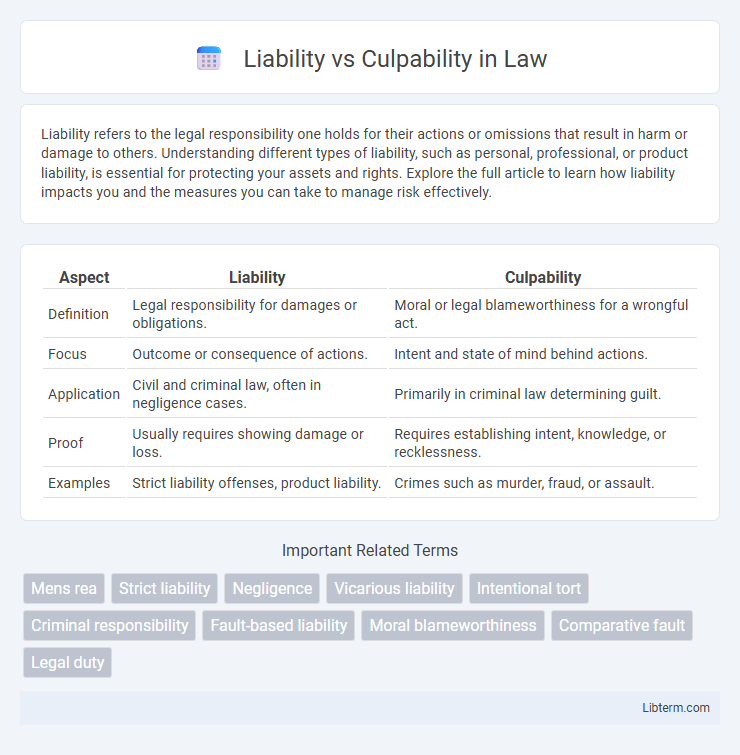Liability refers to the legal responsibility one holds for their actions or omissions that result in harm or damage to others. Understanding different types of liability, such as personal, professional, or product liability, is essential for protecting your assets and rights. Explore the full article to learn how liability impacts you and the measures you can take to manage risk effectively.
Table of Comparison
| Aspect | Liability | Culpability |
|---|---|---|
| Definition | Legal responsibility for damages or obligations. | Moral or legal blameworthiness for a wrongful act. |
| Focus | Outcome or consequence of actions. | Intent and state of mind behind actions. |
| Application | Civil and criminal law, often in negligence cases. | Primarily in criminal law determining guilt. |
| Proof | Usually requires showing damage or loss. | Requires establishing intent, knowledge, or recklessness. |
| Examples | Strict liability offenses, product liability. | Crimes such as murder, fraud, or assault. |
Understanding Liability: Legal Responsibilities Defined
Liability refers to the legal obligation to compensate for damages or losses caused by one's actions or negligence, regardless of intent. It establishes responsibility in civil law, requiring a party to make restitution or face penalties when their conduct breaches a duty of care. Understanding liability involves recognizing how laws assign accountability for harm, emphasizing the objective evaluation of actions over moral blame.
What is Culpability? Moral and Legal Guilt Explained
Culpability refers to the degree of blameworthiness or responsibility an individual holds for a wrongful act, reflecting both moral and legal guilt. It assesses the intent, knowledge, and recklessness of the person's actions in causing harm or violating laws, distinguishing between accidental and intentional misconduct. In legal contexts, culpability determines the severity of charges and penalties by establishing whether the individual acted with negligence, recklessness, or intentional wrongdoing.
Key Differences Between Liability and Culpability
Liability refers to the legal responsibility for one's actions or omissions, often involving financial compensation or penalties, while culpability denotes the degree of blameworthiness or fault in causing harm or wrongdoing. Liability can be strict or negligence-based, meaning a party may be held accountable without intent, whereas culpability requires demonstrating intent, recklessness, or negligence. Understanding these distinctions is crucial in legal contexts, as liability addresses the obligation to remedy harm, and culpability focuses on moral or legal blame.
Types of Liability in Law
Types of liability in law include strict liability, where fault or intent is not required for legal responsibility; negligence liability, which arises from a breach of duty causing harm; and vicarious liability, where one party is held responsible for the actions of another, such as employers for employees. Liability focuses on legal obligation and accountability, whereas culpability emphasizes moral blameworthiness in wrongful acts. Understanding these distinctions aids in navigating civil and criminal cases involving responsibility and fault.
Degrees of Culpability: From Negligence to Intent
Degrees of culpability range from negligence, where a failure to exercise reasonable care causes harm unintentionally, to recklessness, involving conscious disregard of substantial risks, and extend to intentional wrongdoing, where harm is deliberately caused. Liability often depends on the specific degree of culpability established, with negligence typically leading to civil liability, while intent and recklessness can result in criminal liability. Understanding these distinctions is crucial for accurately assessing responsibility and determining appropriate legal consequences.
When Liability Exists Without Culpability
Liability exists without culpability primarily in strict liability cases where the defendant is held responsible for damages regardless of intent or negligence, such as in product liability or environmental law. This legal principle ensures accountability for harm caused by inherently dangerous activities or defective products without requiring proof of fault. Courts impose liability to protect public safety and encourage higher standards of care, even when the defendant acted without malicious intent or negligence.
Legal Consequences: Civil vs Criminal Contexts
Liability typically pertains to civil law where individuals or entities may be held financially responsible for damages or injuries caused, often resulting in monetary compensation or restitution. Culpability, on the other hand, is associated with criminal law and involves establishing fault or blameworthiness, which can lead to penalties such as fines, imprisonment, or probation. Understanding the distinction between liability and culpability is crucial for determining the appropriate legal consequences in both civil lawsuits and criminal prosecutions.
Case Studies Illustrating Liability and Culpability
Case studies such as the Deepwater Horizon oil spill highlight liability as companies like BP were held financially responsible for environmental damages regardless of intent. In contrast, the Volkswagen emissions scandal exemplifies culpability, where intentional deceit led to criminal charges against executives. These examples emphasize that liability often addresses responsibility for consequences, while culpability involves moral or legal blame for wrongful actions.
How Courts Assess Liability and Culpability
Courts assess liability by examining factual evidence to determine whether a party is legally responsible for harm or damages, focusing on negligence, duty of care, and breach thereof. Culpability is evaluated through the defendant's mental state, intent, or recklessness, often influencing the severity of penalties or criminal charges. Legal standards such as "preponderance of evidence" for civil cases and "beyond reasonable doubt" for criminal cases guide judicial determinations of liability and culpability.
Implications for Businesses and Individuals
Liability imposes a legal obligation on businesses and individuals to compensate for harm or damages caused, regardless of intent, whereas culpability involves establishing fault or intentional wrongdoing. For businesses, liability often results in financial penalties, regulatory scrutiny, and reputational damage, impacting operational sustainability. Individuals face personal financial loss and potential criminal charges under culpability, highlighting the importance of risk management and compliance strategies in both contexts.
Liability Infographic

 libterm.com
libterm.com